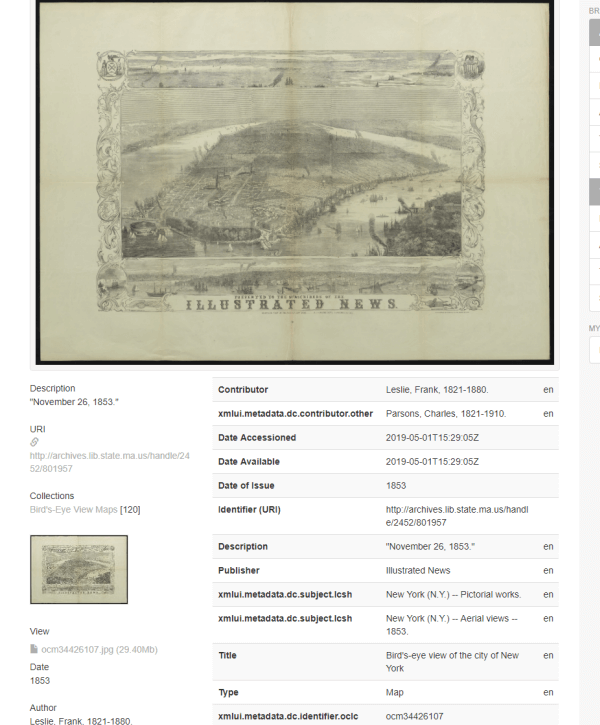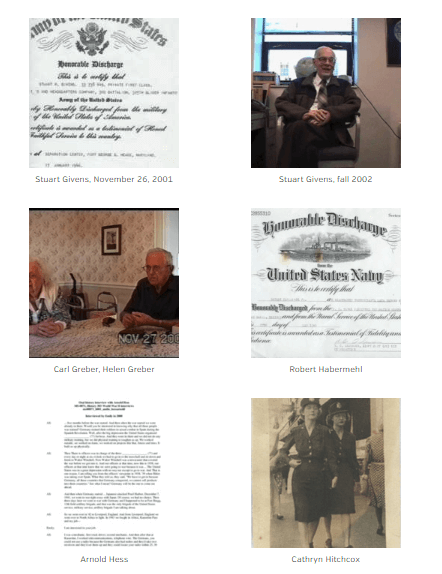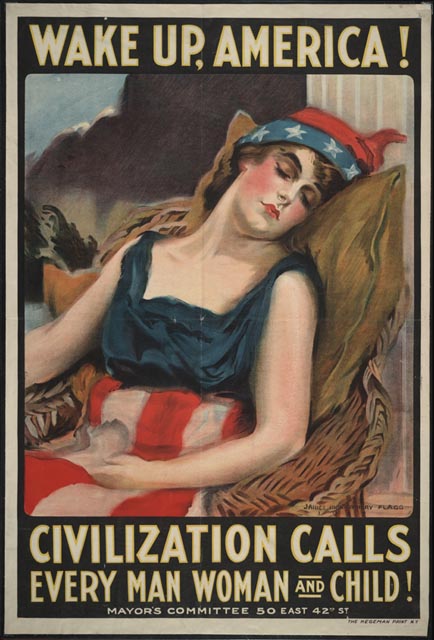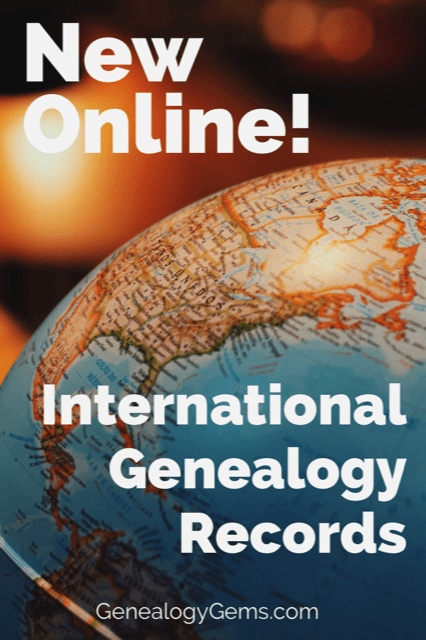You can search and browse the collection in the State of Massachusetts’ DSpace online repository here.
 Here’s this week’s roundup of new genealogy records online: Australia, France, New Zealand and, in the U.S., records for AK, CO, IL, IN, MA, MD, ME, NH, NY, PA and WI.
Here’s this week’s roundup of new genealogy records online: Australia, France, New Zealand and, in the U.S., records for AK, CO, IL, IN, MA, MD, ME, NH, NY, PA and WI.
AUSTRALIA – NORTHERN TERRITORY – PROBATE. Ancestry.com has a new probate index (1911-1994) for Northern Territory, Australia. The collection includes images of an index “organized first by year range, then alphabetically by surname and given name.”
FRANCE – MILITARY. FamilySearch.org has published a new online index to military conscription records for Saône-et-Loire (1867-1940). Privacy restrictions apply to those born less than 120 years ago.
NEW ZEALAND – PROBATE. More than 350,000 browsable records (and over 10,000 indexed records) have been added to a free FamilySearch.org collection of New Zealand probate records (1843-1998). Original records are sourced from Archives New Zealand offices in Auckland, Wellington, Christchurch and Dunedin.
US – VARIOUS – MARINE. Over 315,000 records are part of a new Ancestry.com collection of applications for seaman’s protection certificates, (1916-1940).
US – VARIOUS – MARRIAGE. Findmypast.com announced the addition of around 10 million additional U.S. marriage records to its growing online collection. According to a press release, “This second installment includes significant additions from Indiana, New York, Illinois, Pennsylvania and Maine.” Nearly a million of these are new to online publication and, at least for now, exclusive to Findmypast. (The collection is part of a FamilySearch partnership.)
US – VARIOUS – PROBATE. Ancestry.com has updated its collections of wills and probate records for Wisconsin, Maryland and Colorado. Coverage by time period and county varies.
US – ARKANSAS – CIVIL WAR. About 172,000 indexed records have been added to a free FamilySearch collection of Arkansas Ex-Confederate Pension Records (1891-1939).
US – MASSACHUSETTS – TOWN CLERK RECORDS. FamilySearch has added nearly half a million indexed names to its free online collection, Massachusetts Town Clerk Vital and Town Records 1626-2001. A new related collection of Massachusetts town records is also available on FamilySearch.
US – NEW HAMPSHIRE. Over 100,000 indexed records have been added to a free FamilySearch.org collection of New Hampshire Birth Certificates (1901-1909). According to the collection description, “Records consist of index cards that give the town and date of the event and often much more information.”
 New genealogy records appear online by the millions every week. Keep current by subscribing to the free weekly Genealogy Gems email newsletter. The newsletter comes with a free e-book by Lisa Louise Cooke on Google search strategies you can use to find MORE genealogy records online that you need. Simply enter your email address in the box at the top of this webpage where it says “Sign up.”
New genealogy records appear online by the millions every week. Keep current by subscribing to the free weekly Genealogy Gems email newsletter. The newsletter comes with a free e-book by Lisa Louise Cooke on Google search strategies you can use to find MORE genealogy records online that you need. Simply enter your email address in the box at the top of this webpage where it says “Sign up.”
You’re going to want to make some time in your schedule this week to explore these new genealogy records that just might help you discover a new branch of your family tree! This week we highlight a wide variety of intriguing records including historical maps, oral histories, workhouse records, and historical newspapers. (Disclosure: This article contains affiliate links and Genealogy Gems will be compensated if you make a purchase after clicking on these links (at no additional cost to you). Thank you for helping us bring these free articles to you!)

You can search and browse the collection in the State of Massachusetts’ DSpace online repository here.
World War II ended in 1945 making a man who enlisted at the age of 18 that year, 92 years old today. A new digital archive at Bowling Green State University is striving to digitize old cassette tapes and video tapes that contain interviews with over 100 veterans from Ohio.
According to the website, the exhibit “provides full digital access to the History 303 World War II oral histories (MS-0871). The oral histories were collected from 2000-2004 for a “History of World War II” (History 303) course taught by Drs. Walter E. Grunden and Kathren Brown in the BGSU Department of History, who assigned students the project of recording an interview with an individual who directly experienced the war, whether as a military veteran, Holocaust survivor, refugee, or non-combatant on the home front.”

BGSU’s World War II veteran oral histories include both men and women. who served.
The project is part of a $6,700 grant the university received from the Ohio History Connection. A helpful finding aid is available for the collection here at the BGSU website.
You can search and view the interview here. If you’re like me, you’ll find these interviews with many of the Greatest Generation compelling to watch even if you don’t have relatives from Ohio.
Findmypast has added over 400,000 Donegal, Ireland records to their growing collection of Irish Workhouse records.
The Donegal Workhouses Registers and Minute Books have been digitized and published online for the first time by Findmypast in partnership with the Donegal County Council.
The records consist of both transcripts and images of original admission and discharge registers as well as board of guardians’ minute books spanning the years 1840 to 1922.
The collection covers the unions of:
As well as registers and minute books, users can also expect to find:
From Findmypast: “High levels of poverty in 19th century Ireland meant that hundreds of thousands of Irish people passed through the workhouses. Irish workhouses were generally built to accommodate around 800 inmates although it soon became clear that more space was needed and programme of building took place throughout the 1840s and 50s.

Former workhousein Dunfanaghy, Donegal Flickr user nz_willowherb [CC BY 2.0 (https://creativecommons.org/licenses/by/2.0)]
Life inside was grim. At first, there was no so-called outdoor relief, as would have been common in England. Outdoor relief was when the poor could simply use the workhouse facilities as needed by undertaking a day’s work. Indoor relief was initially the only option and required the poor to prove they were destitute before they were admitted.”
This new collection is part of an existing archive of Irish Workhouse records which now includes over 3.1 million records covering Dublin, Clare, Sligo and Waterford.
Findmypast has added 137,896 new pages to The Archive. These have been added to 18 existing publications spanning 128 years from 1871 to 1999.
The historical newspapers with new additions include:
Search these new records and images by clicking on the collection links below. The number shown in parenthesis is the number of indexed records added.
Australia: Australia, South Australia, Prison Records, 1838-1912 (81,971) New indexed records collection
Belgium: Belgium, Namur, Civil Registration, 1800-1912 (402) Added indexed records to existing collection
Canada: Nova Scotia Births, 1864-1877 (183,455) Added indexed records to an existing collection
Canada: Nova Scotia Marriages, 1864-1918 (18,885) Added indexed records to an existing collection
England: England, Herefordshire Bishop’s Transcripts, 1583-1898 (594,707) New indexed records collection
Germany: Germany, Saxony-Anhalt, Halberstadt, Civil Registration, 1874-1982 (12,060) Added indexed records to an existing collection
Lesotho: Lesotho, Evangelical Church Records, 1828-2005 (302) Added indexed records to an existing collection
Liberia: Liberia, Marriage Records, 1912-2015 (2,475) Added indexed records to an existing collection
Luxembourg: Luxembourg, Civil Registration, 1796-1941 (73,901) Added indexed records to an existing collection
Peru: Peru, Cemetery Records, 1912-2013 (42,164) New indexed records collection
Scotland: Scotland Presbyterian & Protestant Church Records, 1736-1990 (109,064) New indexed records collection
United States: Arkansas Confederate Pensions, 1901-1929 (33,779) Added indexed records to an existing collection
United States: Arkansas, Church Records, 1922-1977 (306) New indexed records collection
United States: California, Church Records, 1864-1985 1,941 New indexed records collection
United States: California, Santa Clara County, San Jose, Oak Hill Cemetery Headstone Inscriptions, 1838-1985 (61,966) New indexed record collection
United States: Colorado, Church Records, 1692-1942 (35,030) New indexed records collection
United States: Connecticut, Vital Records, Prior to 1850 (8) Added indexed records to existing collection
United States: Massachusetts, City of Boston Voter Registers, 1857-1920 (32,996) New indexed records collection
United States: Michigan, Civil War Centennial Observance Commission, Committee on Civil War Grave Registration, Burial Records (15,951) New indexed records collection
United States: Minnesota, County Deaths, 1850-2001 (8,672) Added indexed records to an existing collection
United States: Nebraska, Box Butte County, Funeral Home Records, 1919-1976 (3,491) Added indexed records to an existing collection
United States: Nebraska, Church Records, 1875-1899 (151) New indexed records collection
United States: Pennsylvania, Berks County, Reading, Charles Evans Cemetery and Crematory Burial Records, 1887-1979 (106,043) New indexed records collection
United States: Texas, Bexar County, San Antonio Cemetery Records, 1893-2007 (4,981) Added indexed records to an existing collection
United States: United States Deceased Physician File (AMA), 1864-1968 (78,215) Added indexed records to an existing collection
Did you find an ancestor or bust a brick wall using our list of new online genealogical records? Please leave a comment below and share your story and inspire others. And while you’re at it, please share this article using our social buttons (at the top of this article) with your genealogy friends. We thank you, and they will too!

With the 100th anniversary of America entering World War I, this week we’re shining the spotlight on an immense collection of important WWI records that are available for free at FamilySearch. Here are all the details from their recent press release:
Salt Lake City, Utah (4 April 2017), Did your ancestor serve in World War I? As the centennial of the United States’ entry into World War I approaches, FamilySearch International is highlighting its free online collections of World War I records. Millions of free draft registration, service, and naturalization records online help fill in details about ancestors who served in the military during the conflict. April 6, 2017, will mark the centennial of the United States’ entry into World War I. Search the free collections at FamilySearch.org.
A century ago, the United States joined its allies to fight in World War I—the “Great War” or the “War to End All Wars.” When the U.S. joined the war effort, battles had already raged in Europe for nearly three years between the Allies and the Central Powers.

Almost five million American military personnel marched to war under the command of General John Pershing, commander-in-chief of the American Expeditionary Force. More than 116,000 Americans died in the war—about half from the Spanish Flu pandemic that swept the globe in 1918, killing millions around the world. Nearly 30,000 American military died of the flu before they even got to France.
The country followed the news of the war, with many people supporting the war effort in industry, farming, and other ways as they waited anxiously for the return of their loved ones. On November 11, 1918, about a year and a half after the United States entered the war, Germany formally surrendered, and terms of peace were negotiated. The nation rejoiced as soldiers returned home to rejoin their families and normal lives. But their experiences helped shape their lives, their posterity, and the country.
As the country remembers that war, many families seek to document the stories of their ancestors and friends who participated in the conflict. The veterans of that conflict are gone now, but many Americans are still alive who listened to the stories told by their parents, grandparents, and great-grandparents of their families’ experience during World War I. Some have documents and old letters, but not everyone has such personalized memorabilia. They may find documents in FamilySearch’s searchable online collections to provide insights.
FamilySearch World War I Records Collections:
To find details about an ancestor’s military service, start with the Family History Research Wiki, which directs readers to related documents. Type World War I into the search box in the wiki. The results provide historical context to events during the war, suggestions of records that may provide World War I information, and links to records on other websites.
The most extensive collection on FamilySearch.org is the United States World War I Draft Registration Card collection, with nearly 25 million records. During the course of the war, the amount and kind of information required on draft cards changed, but draft registration cards typically included at least the registrant’s full name, home address, birth date, birthplace, marital status, occupation, physical description, and more.
In addition, many states have registration indexes and card collections that may include other information. For example, searchable state service-card collections on FamilySearch.org for:
provide information about service records, injuries, periods of service, place of birth, age at service or date of birth, units served with, and more for hundreds of thousands of military personnel.
FamilySearch.org has also published searchable images of World War I Enemy Alien Registration Affidavits from San Francisco, California. This collection of records has nearly 34,000 records that offer invaluable genealogical information about noncitizen families during the war, including birth location, countries of citizenship, children, siblings, extended family, educational level, date of arrival in the United States, occupation, languages spoken, a description and a photo of the registrant, and more.
The United States Index to Naturalizations in World War I Soldiers, 1918 offers both indexed information about citizens naturalized during the war and links to images of the actual records.
Census records provide further clues about military service. The 1920 census did not ask questions specific to military service, but the 1930 and 1940 censuses did. Searchable images of the census sheets are online at FamilySearch.org.
One less-known collection containing information about the World War I military comes in records from the Young Men’s Christian Association (YMCA). This volunteer organization provided programs and supplies to support the troops, the sick and wounded, and prisoners of war. Family Search.org has 27,000 images from the YMCA World War I Service Cards, 1917–1919 collection that provide names, addresses, work, religious affiliation, and army service information.
The following World War I books can be found in FamilySearch’s digital book collection online:
Here are three more Genealogy Gems articles to help you discover more about the impact of the Great War on your ancestors:
WWI History App in New and Updated Genealogical Collections
A WWI history app for genealogy leads our top picks for this week! History buffs are going to love Remembering WWI, an app that makes your WWI family history come alive. Also in this week’s new and updated genealogical collections, Swedish church records, Canadian marriage records, Pennsylvania naturalizations, and more.
3 Tips for Finding WWI Ancestors and Their Stories
How did World War I affect your family’s lives? Start your search with these 3 tips for finding WWI ancestors.
Europeana for Genealogy: WWI Digital Archive and More
A major part of Europeana is its World War I digital archive. As the site describes, Europeana “has been running World War I family history roadshows around Europe, helping to digitize people’s stories, documents and memorabilia from 1914-1918.
Here are the latest genealogy records newly online from Findmypast. You’ll find a large selection from Scotland, and others from around the world.

Scotland, Published Family Histories
Is your family from Scotland? Discover more about your Scottish families’ name and history from this collection of publications. There are over 400 publications in this collection of Scottish family histories.
The publications mostly date from the 19th and early 20th centuries, they include memoirs, genealogies, and clan histories. There are also publications that have been produced by emigrant families.
Scotland, Newspaper Birth Notices
Over 121,000 new records have been added to our collection of Scottish newspaper birth notices. These new additions have been transcribed from our existing collection of Scottish newspapers.
Each record includes a transcript and an image of the original newspaper announcement. The amount of information listed varies, but most records will list a combination of your ancestor’s birth date, birth place and parents’ names.
Scotland, Newspaper Marriage & Anniversary Notices
A further 201,000 new records have also been added to our notices of marriages and anniversaries.
Also taken from our existing collection of historical newspapers, the records will include a combination of your ancestor’s marriage date, marriage place, spouse’s name and parents’ names. Images of the original notices may reveal additional details.
Scotland, Newspaper Death Reports & Obituaries
Over 500,000 additional records are now available to search. This collection of newspaper death reports and obituaries may reveal interesting or undiscovered stories surrounding your ancestors’ life and death.
Transcripts will reveal your ancestor’s death date, age at death, parents’ names and the name of their spouse.
Scotland, Glasgow & Lanarkshire Death & Burial Index
Over 37,000 records have been added to the Glasgow & Lanarkshire Death & Burial Index. These new additions cover Bent Cemetery in Hamilton and consist of transcripts of original documents that will reveal a combination of your ancestors’ birth year, death and burial dates, age at death, burial place and mortcloth price.
Scotland, Court & Criminal Database
Over 28,000 records from the Fife Kalendar of Convicts have been added to our collection of Scottish crime records.
The result of a 20 year project by Andrew Campbell of the Fife Family History Society, the Kalendar is an indexing to many of the courts in Fife as well as the High Court between 1708 and 1909. It includes information taken from a variety of sources ranging from court, prison and transportation records to births, marriages, deaths and newspaper reports.
Each result will include a transcript of the original document. The amount of information listed in each transcript will vary, but most will reveal a combination of the accused’s name, birth year, birth place, address and occupation, the nature of their offence, the date and location of their trail as well as the sentence they received.
Some records will also include trial notes, verdict comments, details of previous convictions and additional comments.
The Scotland, Court & Criminal Database now contains over 160,000 including Crown Office Precognitions and High Court Trial Papers. Crown Office Precognitions are factual statements that have been given by witnesses to both the prosecution and defence before the case goes to trial. Precognitions differ from a witness statement, a witness statement is an account of what the witness has said or seen were as a precognition is an account of the witness’s evidence.
Church of Scotland Ministers 1560-1949
Explore PDF images of the “The Succession of Ministers on the Church of Scotland from the Reformation”. Compiled by Hew Scott, D.D., The work was revised and continued up to 1949 under the Superintendence of a Committee appointed by the General Assembly.
As quoted in the book, “the design of the present work is to present a comprehensive account of the Succession of Ministers of the Church of Scotland since the period of the Reformation. An attempt is made to give some additional interest by furnishing incidental notices of their lives, writings and families, which may prove useful to the Biographer, the Genealogist, and the Historian.”
Isle of Man Roll Of Honour WW1
Find your Isle of Man ancestors who fell in the Great War. The Isle Of Man Roll Of Honour recorded the names of more than 1,900 men who died during the First World War or died as a result of wounds, injury or disease contracted on active service. These transcripts will reveal your ancestor’s rank, regiment, parish and biography.
Originally published in 1934 by the War Pensions Committee, the publication was funded entirely by Lord Stanley, Earl of Derby.
In 1936, the War Pensions Committee donated copies to each parish church throughout the island.
The foreword, provided by Lord Stanley, reads ‘It is well that the deeds of those who died in the Great War should find a permanent memorial in such a list. Whilst this generation lives their names will not be forgotten, but other generations will arise to whom they will not be personally known. This Roll will serve to keep their memory green and future Manxmen and Manxwomen, when reading it, will realise that in our great struggle the Isle of Man played a noble part’.
International Records Update – Czech Republic
Two new Indexes, Czech Republic Births & Baptisms 1637-1889 and Czech Republic Marriages 1654-1889 are now available to search. These transcripts will provide you with vital dates and locations as well as the names of parents and spouses. Hints will also be generated from these records against any matching names stored in your Findmypast family tree.
International Records Update – Belgium
Celebrate Belgian Independence Day this coming Sunday by discovering your Belgian roots. Explore two indexes, Belgium Marriages 1563-1890 and Belgium Deaths & Burials 1564-1900, containing more than 212,000 records.
These records will enable you to determine when your ancestors died, where they were laid to rest, when they married and the name of their spouse.
International records update – Finland
Search for your Finnish ancestors in three indexes of more than six million baptisms, marriages and burials between 1657 and 1909. These transcripts will also generate hints against any names stored in your Findmypast Family Tree.
Pinpoint your ancestor’s final resting place with new additions to our Billion Graves Cemetery Indexes. Our latest update includes:
Cemetery records are of great importance in discovering where and when your ancestor died. They can also provide you with information regarding their birth and marriage dates.
With an abundance of cemeteries, it can be overwhelming trying to pinpoint the precise cemetery in which your ancestor was laid to rest, and visiting each potential location is costly. However, in partnering with BillionGraves, we aim to make available all the cemetery records held on their site for free, saving you time and money as you search for your ancestor. BillionGraves is the largest resource for GPS-tagged headstone and burial records on the web, with over 12 million headstone records.
International Records Update – Netherlands
Unearth your Dutch roots with three indexes to more than three million births & baptisms, marriages, deaths and burials that took place in the Netherlands between 1564 and 1945.
These transcripts were sourced from the International Genealogical Index and will generate hints against your Findmypast family tree.
Disclosure: This article contains affiliate links and Genealogy Gems will be compensated if you make a purchase after clicking on these links (at no additional cost to you). Thank you for supporting Genealogy Gems!